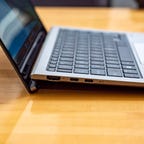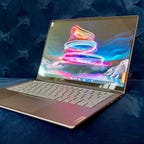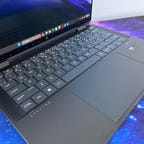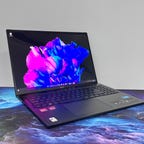Best MacBook Air Alternatives for 2024
Here are the best Windows laptops most similar to Apple's thin, light and long-running MacBook Air, tested and reviewed by CNET's experts.
What to consider
Price
The 13-inch M3 MacBook Air starts at $1,099, and the 15-inch MacBook Air starts at $1,299. You can find similarly sized and designed Windows laptops at these prices, and in some cases the Windows machines will offer more RAM and storage capacity than the baseline configurations from Apple.
Operating system
For the most part, Microsoft Windows and Apple's MacOS do the same things, but they do them differently. Unless there's an OS-specific application you need, go with the one you feel most comfortable using. MacBooks currently start at $999 for the preview M2 version, so if you need a laptop for significantly less, it’s Windows. A Chromebook running on Google’s ChromeOS is an excellent (and less expensive) alternative, but it can’t run Windows or Mac software.
Size
Remember to consider whether having a lighter, thinner laptop or a touchscreen laptop with a good battery life will be important to you in the future. Size is primarily determined by the screen, which in turn factors into battery size, laptop thickness, weight and price.
Screen
When it comes to deciding on a screen, there are many considerations: size, resolution, what types of content you'll be looking at and whether you'll be using it for gaming or creative work. Higher resolutions are better for fitting more on a screen and look for a dot pitch of at least 100 pixels per inch as a rule of thumb.
Processor
The processor, aka the CPU, is the brains of a laptop. Intel and AMD are the main CPU makers for Windows laptops, and Apple makes its own chips for MacBooks. Generally, the faster the processor speed and the more cores it has, the better the performance will be but at the expense of battery life.
Graphics
The graphics processor (GPU) handles all the work of driving the screen and generating what gets displayed, as well as speeding up a lot of graphics-related (and increasingly, AI-related) operations. For Windows laptops, there are two types of GPUs: integrated (iGPU) or discrete (dGPU), while Apple integrates its GPU into its own M2 or M3 processor.
Memory
We highly recommend 16GB of RAM, with 8GB being the absolute minimum. RAM is where the operating system stores all the data for currently running applications, and it can fill up fast. After that, it starts swapping between RAM and the storage drive, which is slower.
Storage
You'll still find cheaper hard drives in budget laptops and larger hard drives in gaming laptops, but faster solid-state drives (SSDs) have all but replaced hard drives in most models. A 256GB SSD is the minimum, and 512GB will last longer without getting filled up. Opt for 1TB or more if you work with large video files or plan to store a large game library on your laptop.
Our Picks

The HP Pavilion Plus 14 is the best MacBook Air alternative. Like the Air, it boasts an all-metal enclosure, gorgeous display and strong overall performance. Sitting between the meat-and-potatoes Pavilion line and higher-end Envy line, the Pavilion Plus series offers attractive features at affordable prices. With its solid, compact chassis and lengthy battery life, the Pavilion Plus 14 is easy to recommend for home, work or school.
The latest 13-inch MacBook Air with Apple’s M3 chip tops our list as the best overall laptop and best overall MacBook. The 13.6-inch display provides ample room to work while remaining portable, and it's available in a 15-inch size if you want a larger screen and don't want to pay a premium for a MacBook Pro. If you prefer Windows to MacOS, however, there are a number of laptops in addition to the HP Pavilion Plus 14 that approximate a MacBook Air’s slim, modern design and capable, all-around performance for roughly the same price.
With decades of experience testing and reviewing laptops, our laptop experts conduct performance testing under controlled conditions in the CNET Labs and also perform extensive hands-on tests to assess the design, features and performance of each laptop we review. We’ve yet to test a Windows laptop that can match a MacBook Air’s battery life, but some offer features you don’t get with a MacBook Air, including touchscreens and high-res 1440p webcams as well as more than 8GB of RAM and a solid-state drive larger than 256GB without needing to pay an upgrade charge.
The Pavilion Plus 14 follows a similar recipe as the MacBook Air of providing an attractive, aluminum chassis and strong overall performance at an approachable price. Its battery life can’t match that of a MacBook Air, but its 8-hour runtime should suffice for most users. Unlike Apple’s limited upgrade options for the MacBook Air, HP offers a wealth of customization options for the Pavilion Plus 14, including Intel and AMD processors, discrete graphics and an OLED display option.
The starting price is $850, but we recommend getting that OLED screen if you can afford it. It adds about $100 to the package, but it’s worth it. The good news is that HP regularly has deep discounts, so you can get the OLED and a faster processor or more storage and still be around $1,000.
Lenovo Slim 7i
Best MacBook Air alternative wit Core Ultra CPU
The Lenovo Slim 7i is a sturdy and compact laptop that splits the difference between mainstream and premium. Its chief attraction is the 14-inch OLED touch display that boasts vivid colors and stellar contrast. The all-aluminum chassis is rigid, with hardly any flex that rivals the solid unibody enclosure of a MacBook Air. Inside, the Slim 7i features an Intel Core Ultra CPU, an ample 32GB of RAM and a roomy 1TB SSD.
Our test system costs $1,240, but Lenovo tells us that it will soon arrive at Costco for $999. That’s $100 less than the baseline MacBook Air with four times the memory and SSD capacity.
HP Spectre x360 14
Best approximation of MacBook Air design
The premium Spectre x360 14 comes closest of any Windows laptops we’ve reviewed to the sleek sturdiness of a MacBook Air. The all-metal, matte-black chassis is as stunning as the high-resolution, 14-inch OLED display. And with touch support and a 360-degree hinge, the Spectre x360 14 is like an Air and iPad in one with its ability to rotate into tablet mode. It’s also the rare OLED laptop with a runtime longer than 10 hours.
The starting price for this Core Ultra-based laptop is $1,450, which might seem too pricey to compare against a MacBook Air that starts at $1,099, but HP regularly discounts the Spectre x360 14 that drops the price to an Air-like $1,150.
Asus Zenbook S 13 OLED
Thinnest and lightest MacBook Air alternative
It's not easy to find an ultralight laptop that still feels sturdy, but the Asus Zenbook S 13 OLED does. At just 2.2 pounds, the 13.3-inch laptop is appreciably lighter than the 2.7-pound MacBook Air, making it the perfect little travel companion. Despite its compact footprint, Asus squeezed in a comfortable keyboard and a big touchpad. And it features a 13.3-inch, 2.8K OLED display with excellent color and contrast. Based on an efficient 13th-gen Core i7 U-series processor, the Zenbook S 13 OLED offers long battery life, which isn't always the case with an OLED laptop. There's nothing quite like the Zenbook S 13 OLED at its price. It's a commuter's delight.
Acer Swift Edge 16
Best alternative to 15-inch MacBook Air
The Acer Swift Edge 16 offers an uncommon combination of display size and portability. It’s based on a 16-inch OLED display and yet weighs just 2.7 pounds. That’s the same weight at the 13.6-inch MacBook Air and more than a half pound lighter than the 15.3-inch, 3.3-pound MacBook Air.
The $1,300 configuration we reviewed featured a Ryzen 7 7840U, 16GB of RAM, integrated AMD Radeon graphics, a 1TB SSD and a 16-inch OLED display with a 3,200x2,000-pixel resolution and 120Hz refresh rate. That’s the same price as the baseline 15-inch MacBook Air for a larger, higher-resolution display, twice the memory and four times the storage capacity.
HP Dragonfly Pro Chromebook
Closest Chromebook to a MacBook Air
Most Chromebooks are small and plastic and low cost. The HP Dragonfly Pro Chromebook isn't like most Chromebooks. It’s the MacBook Pro of Chromebooks, boasting a beautiful design, excellent display, comfortable keyboard and awesome haptic touchpad. And it offers enough processing power to take advantage of today's ChromeOS features.
The magnesium-and-aluminum enclosure is minimalist and beautiful and sturdy. The lid, keyboard deck and bottom panel all have a matte-black finish with a keyboard to match. The 14-inch display has a crisp, 2,560x1,600-pixel resolution and is exceedingly bright. The keyboard gets top marks even without the surprising and fun inclusion of RGB lighting. And the haptic touchpad is just about perfect. At $1,000, the Dragonfly Pro Chromebook costs more than most Chromebooks and is nearly as pricey as the MacBook Air, but it's worth every penny.
How we test laptops
The review process for laptops consists of two parts: performance testing under controlled conditions in the CNET Labs and extensive hands-on use by our reviewers. This includes evaluating a device's aesthetics, ergonomics and features with respect to price. A final review verdict is a combination of both objective and subjective judgments.
We test all laptops with a core set of benchmarks, including Primate Labs Geekbench 6, Cinebench R23, PCMark 10, a variety of 3DMark benchmarks (whichever can run on the laptop), UL Procyon Photo and Video (where supported), and our own battery life test. If a laptop is intended for gaming, we'll also run benchmarks from Guardians of the Galaxy, The Rift Breaker (CPU and GPU) and Shadow of the Tomb Raider.
For the hands-on, the reviewer uses it for their work during the review period, evaluating how well the design, features (such as the screen, camera and speakers) and manufacturer-supplied software operate as a cohesive whole. We also place importance on how well they work given their cost and where the manufacturer has potentially made upgrades or tradeoffs for its price.
The list of benchmarking software and comparison criteria we use changes over time as the devices we test evolve. You can find a more detailed description of our test methodology on our How We Test Computers page.
Factors to consider
There are a ton of laptops on the market at any given moment, and almost all of those models are available in multiple configurations to match your performance and budget needs. So if you're feeling overwhelmed with options when looking for a new laptop, it's understandable. To help simplify things for you, here are the main things you should consider when you start looking.
Price
The search for a new laptop for most people starts with price. If the statistics chipmaker Intel and PC manufacturers hurl at us are correct, you'll be holding onto your next laptop for at least three years. If you can afford to stretch your budget a little to get better specs, do it. And that stands whether you're spending $500 or more than $1,000. In the past, you could get away with spending less upfront with an eye toward upgrading memory and storage in the future. But laptop makers are increasingly moving away from making components easily upgradable, so again, it's best to get as much laptop as you can afford from the start.
Generally speaking, the more you spend, the better the laptop. That could mean better components for faster performance, a nicer display, sturdier build quality, a smaller or lighter design from higher-end materials or even a more comfortable keyboard. All of these things add to the cost of a laptop. I'd love to say $500 will get you a powerful gaming laptop, for example, but that's not the case. Right now, the sweet spot for a reliable laptop that can handle average work, home office or school tasks is between $700 and $800, and a reasonable model for creative work or gaming upward of about $1,000. The key is to look for discounts on models in all price ranges so you can get more laptop for less.
Operating system
Choosing an operating system is part personal preference and part budget. For the most part, Microsoft Windows and Apple's MacOS do the same things (except for gaming, where Windows is the winner), but they do them differently. Unless there's an OS-specific application you need, go with the one you feel most comfortable using. And if you're not sure which that is, head to an Apple store or a local electronics store and test them out. Or ask friends or family to let you test theirs for a bit. If you have an iPhone or iPad and like it, chances are you'll like MacOS too.
But when it comes to price and variety (and, again, PC gaming), Windows laptops win. If you want MacOS, you're getting a MacBook. While Apple's MacBooks regularly top our best lists, the least expensive one is the M1 MacBook Air for $999. It is regularly discounted to $750 or $800, but if you want a cheaper MacBook, you'll have to consider older refurbished ones.
Windows laptops can be found for as little as a couple of hundred dollars and come in all manner of sizes and designs. Granted, we'd be hard-pressed to find a $200 laptop we'd give a full-throated recommendation to, but if you need a laptop for online shopping, email and word processing, they exist.
If you are on a tight budget, consider a Chromebook. ChromeOS is a different experience than Windows; make sure the applications you need have a Chrome, Android or Linux app before making the leap. But if you spend most of your time roaming the web, writing, streaming video or using cloud-gaming services, they're a good fit.
Size
Remember to consider whether having a lighter, thinner laptop or a touchscreen laptop with a good battery life will be important to you in the future. Size is primarily determined by the screen -- hello, laws of physics -- which in turn factors into battery size, laptop thickness, weight and price. And keep in mind other physics-related characteristics, such as an ultrathin laptop isn't necessarily lighter than a thick one, you can't expect a wide array of connections on a small or ultrathin model and so on.
Screen
When it comes to deciding on a screen, there are myriad considerations: how much you need to display (which is surprisingly more about resolution than screen size), what types of content you'll be looking at and whether you'll be using it for gaming or creative work.
You really want to optimize pixel density; that is, the number of pixels per inch the screen can display. Though there are other factors that contribute to sharpness, a higher pixel density usually means sharper rendering of text and interface elements. (You can easily calculate the pixel density of any screen at DPI Calculator if you don't feel like doing the math, and you can also find out what math you need to do there.) We recommend a dot pitch of at least 100 pixels per inch (ppi) as a rule of thumb.
Because of the way Windows and MacOS scale for the display, you're frequently better off with a higher resolution than you'd think. You can always make things bigger on a high-resolution screen, but you can never make them smaller -- to fit more content in the view -- on a low-resolution screen. This is why a 4K, 14-inch screen may sound like unnecessary overkill, but may not be if you need to, say, view a wide spreadsheet.
If you need a laptop with relatively accurate color, that displays the most colors possible or that supports HDR, you can't simply trust the specs -- not because manufacturers lie, but because they usually fail to provide the necessary context to understand what the specs they quote mean. You can find a ton of detail about considerations for different types of screen uses in our monitor buying guides for general purpose monitors, creators, gamers and HDR viewing.
Processor
The processor, aka the CPU, is the brains of a laptop. Intel and AMD are the main CPU makers for Windows laptops. Both offer a staggering selection of mobile processors. Making things trickier, both manufacturers have chips designed for different laptop styles, like power-saving chips for ultraportables or faster processors for gaming laptops. Their naming conventions will let you know what type is used. You can head to Intel's or AMD's sites for explanations so you get the performance you want. Generally speaking, though, the faster the processor speed and the more cores it has, the better the performance will be.
Apple makes its own chips for MacBooks, which makes things slightly more straightforward. But, like Intel and AMD, you'll still want to pay attention to the naming conventions to know what kind of performance to expect. Apple uses its M-series chipsets in Macs. The entry-level MacBook Air uses an M1 chip with an eight-core CPU and seven-core GPU. The current models have M2-series silicon that starts with an eight-core CPU and 10-core GPU and goes up to the M2 Max with a 12-core CPU and a 38-core GPU. Again, generally speaking, the more cores it has, the better the performance.
Graphics
The graphics processor (GPU) handles all the work of driving the screen and generating what gets displayed, as well as speeding up a lot of graphics-related (and increasingly, AI-related) operations. For Windows laptops, there are two types of GPUs: integrated (iGPU) or discrete (dGPU). As the names imply, an iGPU is part of the CPU package, while a dGPU is a separate chip with dedicated memory (VRAM) that it communicates with directly, making it faster than sharing memory with the CPU.
Because the iGPU splits space, memory and power with the CPU, it's constrained by the limits of those. It allows for smaller, lighter laptops, but doesn't perform nearly as well as a dGPU. In fact, there are some games and creative software that won't run unless they detect a dGPU or sufficient VRAM. Most productivity software, video streaming, web browsing and other nonspecialized apps will run fine on an iGPU, though.
For more power-hungry graphics needs, like video editing, gaming and streaming, design and so on, you'll need a dGPU; there are only two real companies that make them, Nvidia and AMD, with Intel offering some based on the Xe-branded (or the older UHD Graphics branding) iGPU technology in its CPUs.
Memory
For memory, we highly recommend 16GB of RAM (8GB absolute minimum). RAM is where the operating system stores all the data for currently running applications, and it can fill up fast. After that, it starts swapping between RAM and SSD, which is slower. A lot of sub-$500 laptops have 4GB or 8GB, which in conjunction with a slower disk can make for a frustratingly slow Windows laptop experience. Also, many laptops now have the memory soldered onto the motherboard. Most manufacturers disclose this, but if the RAM type is LPDDR, assume it's soldered and can't be upgraded.
However, some PC makers will solder memory on and also leave an empty internal slot for adding a stick of RAM. You may need to contact the laptop manufacturer or find the laptop's full specs online to confirm. And check the web for user experiences, because the slot may still be hard to get to, it may require nonstandard or hard-to-get memory or other pitfalls.
Storage
You'll still find cheaper hard drives in budget laptops and larger hard drives in gaming laptops, but faster solid-state drives (SSDs) have all but replaced hard drives in laptops. They can make a big difference in performance. But not all SSDs are equally speedy, and cheaper laptops typically have slower drives; if the laptop has only 4GB or 8GB of RAM, it may end up swapping to that drive and the system may slow down quickly while you're working.
Get what you can afford, and if you need to go with a smaller drive, you can always add an external drive or two down the road or use cloud storage to bolster a small internal drive. The one exception is gaming laptops: We don't recommend going with less than a 512GB SSD unless you really like uninstalling games every time you want to play a new game.
Laptop FAQs
How much do good laptops cost?
Setting a budget is a good place to start when shopping for the best laptop for yourself. The good news is you can get a nice-looking, lightweight laptop with excellent battery life at prices under $500. If you're shopping for a laptop around $500 or less, check out our top picks here, as well as more specific buying advice for that price range.
Higher-end components like Intel Core Ultra and AMD Ryzen processors and premium design touches like thin-display bezels and aluminum or magnesium bodies have made their way to laptops priced between $500 and $1,000. You can also find touchscreens and two-in-one designs that can be used as a tablet or a laptop -- and a couple other positions in between. In this price range, you'll also find faster memory and SSD storage -- and more of it -- to improve performance.
Above $1,000 is where you'll find premium laptops and two-in-ones. If you're looking for the fastest performance, the best battery life, the slimmest, lightest designs and top-notch display quality with an adequate screen size, expect to spend at least $1,000.
Which is better: MacOS or Windows?
Deciding between MacOS and Windows laptop for many people will come down to personal preference and budget. Apple's base model laptop, the M1 MacBook Air, starts at $999. You can sometimes find it discounted or you can get educational pricing from Apple and other retailers. But in general, it'll be at least $1,000 for a new MacBook, and the prices just go up from there.
For the money, though, you're getting great hardware top to bottom, inside and out. Apple recently moved to using its own processors, which resulted in across-the-board performance improvements compared to older Intel-based models. But, the company's most powerful laptop, the 16-inch MacBook Pro, still hasn't been updated to Apple silicon.
But, again, that great hardware comes at a price. Also, you're limited to just Apple laptops. With Windows and Chromebooks (more on these below), you get an amazing variety of devices at a wide range of prices.
Software between the two is plentiful, so unless you need to run something that's only available on one platform or the other, you should be fine to go with either. Gaming is definitely an advantage for a Windows laptop, though.
MacOS is also considered to be easier and safer to use than Windows, especially for people who want their computers to get out of the way so they can get things done. Over the years, though, Microsoft has done its best to follow suit and, with Windows 11 here, it's trying to remove any barriers. Also, while Macs might have a reputation for being safer, with the popularity of the iPhone and iPad helping to drive Mac sales, they've become bigger targets for malware.
Are Chromebooks worth it?
Yes, they are, but they're not for everyone. Google's Chrome OS has come a long way in the 10-plus years since they arrived and Chromebooks -- laptops that run on Chrome OS -- are great for people who do most of their work in a web browser or using mobile apps. They are secure, simple and, more often than not, a bargain. What they can't do is natively run Windows or Mac software.
What's the best laptop for home, travel or both?
The pandemic changed how and where a lot of people work. The small, ultraportable laptops valued by people who regularly traveled may have suddenly become woefully inadequate for working from home. Or maybe instead of needing long battery life, you'd rather have a bigger display with more graphics power for gaming.
If you're going to be working on a laptop and don't need more mobility than moving it from room to room, consider a 15.6-inch laptop or larger. In general, a bigger screen makes life easier for work and is more enjoyable for entertainment, and it also is better if you're using it as an extended display with an external monitor. It typically means you're getting more ports too, so connecting an external display or storage or a keyboard and mouse are easier without requiring a hub or dock.
For travel, stay with 13- or 14-inch laptops or two-in-ones. They'll be the lightest and smallest while still delivering excellent battery life. What's nice is that PC-makers are moving away from 16:9 widescreens toward 16:10- or 3:2-ratio displays, which gives you more vertical screen space for work without significantly increasing the footprint. These models usually don't have discrete graphics or powerful processors, though that's not always the case.
Which laptop is best for gaming or creating?
You can play games and create content on any laptop. That said, what games you play and what content you create -- and the speed at which you do them -- is going vary greatly depending on the components inside the laptop.
For casual browser-based games or using streaming-game services like Nvidia GeForce Now and Xbox Cloud Gaming, you don't need a powerful gaming laptop. And similarly, if you're trimming video clips, cropping photos or live-streaming video from your webcam, you can get by with a modestly priced laptop or Chromebook with integrated graphics.
For anything more demanding, you'll need to invest more money in discrete graphics like Nvidia's RTX 30- or 40-series GPUs. Increased system memory of 16GB or more, having a speedy SSD of at least 512GB for storage and a faster processor such as an Intel Core i7 or AMD Ryzen 7 will all help you get things moving faster too.
The other piece you'll want to consider is the display. For gaming, look for screens with a high refresh rate of 120Hz or faster so games look smoother while playing. For content creation, look for displays that cover at least 100% sRGB color space or, better yet, 100% DCI-P3.





